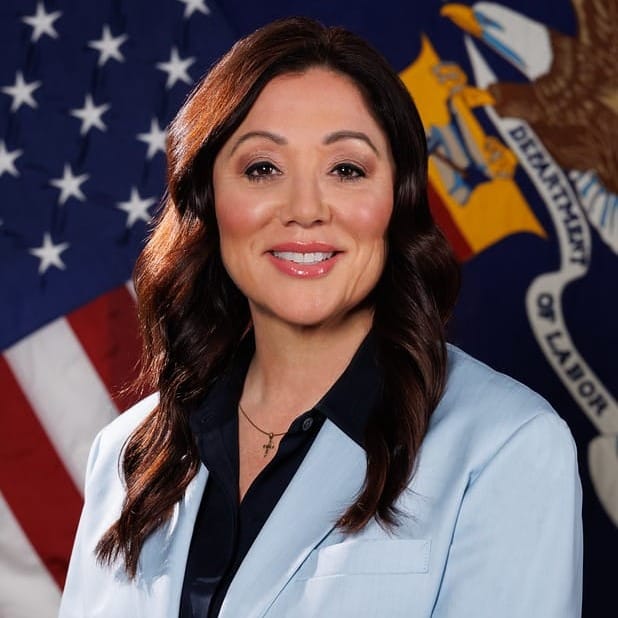As the first calendar year under new leadership at the Department of Labor and the SEC nears a close, wealth management professionals are wondering what’s happened and what’s in store for next year. This primer can get you up to speed.
On March 11, Lori Chavez-DeRemer became the 30th Secretary of the DOL. Previously, she served in the U.S. House of Representatives for Oregon’s 5th congressional district. On April 21, Paul S. Atkins became the 34th Chairman of the SEC. Previously, he served as an SEC Commissioner during the George W. Bush administration from 2002 to 2008.
As appointees of the administration of President Donald Trump, Chavez-DeRemer and Atkins are widely perceived as overseeing lighter touches to regulatory supervision and enforcement than their immediate predecessors, who served under the Joe Biden administration.
Rethinking Regulatory Regimes
The major question right now for financial advisors – as well as the compliance teams and leaders of their firms – is how the DOL and SEC will address the fiduciary rule, the independent-contractor rule, cybersecurity, documentation and disclosure requirements in 2026. Of course, that’s just the tip of the iceberg regarding all the potential issues that could be on regulators’ radar next year.

In an August 12 announcement, the DOL’s Employee Benefits Security Administration rescinded a 2021 statement that discouraged fiduciaries from considering alternative assets in 401(k)s. “This is just another example of how the Biden administration put their thumb on the scale to pick winners and losers,” Chavez-DeRemer said in the announcement. “Instead of allowing Washington bureaucrats to call the shots, we believe plan fiduciaries should decide which retirement investment options are best for hardworking Americans.”
In his Sept. 18 Remarks at the Investor Advisory Committee Meeting, Atkins said, “In the last decade alone, private fund assets have almost tripled from $11.6 trillion to $30.9 trillion. Allowing this option could increase investment opportunities for retail investors seeking to diversify their investment allocation in line with their investment time horizon and risk tolerance. In that spirit, I was therefore delighted by President Trump’s Executive Order to democratize access to alternative assets.”
On Sept. 4, the DOL released its Semi-Annual Regulatory Agenda. It announced that the DOL would consider the extent to which fiduciaries may prioritize environmental, social and governance factors in investment decisions. The DOL also announced that it would examine the circumstances under which a worker should be classified as an employee or independent contractor for the purpose of federal wage and hour requirements.
Its fiduciary rule was put on pause due to a stay of effective date in two Texas civil cases, brought by the Federation of Americans for Consumer Choice and the American Council of Life Insurers. Although the independent-contractor rule took effect on March 11, 2024, it is the subject of five separate legal challenges, so the DOL intends to rescind the rule and is considering how it will proceed under the Fair Labor Standards Act.

Also on Sept. 4, the SEC released its Spring 2025 Unified Agenda of Regulatory and Deregulatory Actions. It includes that the SEC considers inviting public comment to inform a comprehensive rethink of the Consolidated Audit Trail (CAT); proposing amendments and/or new rules to improve regulations around the custody of advisory client and fund assets; and issuing jointly with the Treasury Department a final terrorism prevention rule requiring advisors to implement customer identification programs.
Furthermore, the SEC announced that it is considering recommending the proposal of rules on the offer and sale of crypto assets, potentially including exemptions and safe harbors, to enhance regulatory clarity. Separately, the SEC is considering recommending the amendment of Exchange Act Rules to account for the trading of crypto assets on alternative trading systems and national securities exchanges.
Eyeing Exams & Enforcement
To gain a better sense of the ever-evolving landscape, WSR gathered insights from Sid Yenamandra, Founder and CEO of SurgeONE.ai; Kaitlyn Wulfken, Director of Compliance Risk Concepts; and Todd Spillane, President of Essential Edge Compliance Outsourcing Services.

Yenamandra noted that, with the fiduciary rule tied up in litigation and the fate of the independent-contractor rule uncertain, advisors tightened rollover documentation, disclosure practices and staffing structures. Therefore the DOL is likely to extend pauses, refine guidance under PTE 2020-02 (a prohibited transaction exemption under ERISA and the Internal Revenue Code for investment advice fiduciaries regarding employee benefit plans and IRAs), and clarify independent-contractor standards through bulletins rather than sweeping new rules.
“These pressures increased the need for clear audit trails, conflict management and vendor oversight. The year underscored the importance of blending compliance frameworks with cyber and data governance,” Yenamandra says. “Advisors should be ready for targeted enforcement that tests documentation, disclosures and reliance on data systems supporting fiduciary oversight.”

As Wulfken sees it, under Atkins the SEC has leaned decisively into deregulation by deferring ambitious anti-money laundering (AML) obligations to 2028, rolling back ESG and climate mandates, narrowing exam scope, and slashing rule proposals.
“This ‘return to basics’ posture is framed as pro-Main Street, but many rollbacks seem more about loosening restrictions for institutional players than strengthening investor safeguards,” she says. “In 2026, we anticipate that regulation will tilt toward targeted exams and risk alerts over sweeping rulemaking.”
Wulfken expects the SEC to focus on fiduciary principles, conflicts, custody practices and technology oversight. She also is looking for SEC guidance, risk alerts and interpretive shifts to carry more weight than new rules, requiring advisors to demonstrate resilient documentation and adaptable compliance frameworks.

According to Spillane, the manner in which wealth management industry compliance approaches and resources have adapted to the changes means that firms need more technology to complete all their regulatory requirements. They need more expertise in the regulatory area, he insists, even larger firms, as the requirements are extremely broad.
“There will be much less rule-making in 2026, which is good for the industry to take a breather, but when regulators come calling, they will expect their requests for data to be produced rapidly,” Spillane says.
Chris Latham, Contributing Editor, Strategic Advisor at Wealth Solutions Report, can be reached at clatham@wealthsolutionsreport.com.














